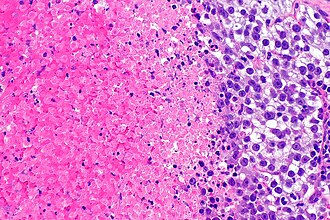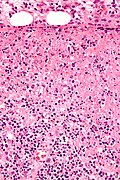Difference between revisions of "Necrosis"
(create) |
(fix typo found by AC) |
||
| (22 intermediate revisions by 2 users not shown) | |||
| Line 1: | Line 1: | ||
'''Necrosis''' is a type of cell death that is characterized by inflammation. | [[Image:Seminoma with necrosis -- high mag.jpg|thumb|right|Necrosis (left of image) in a [[seminoma]] (right of image). [[H&E stain]].]] | ||
'''Necrosis''' is a type of cell death that is characterized by inflammation. | |||
==Classic types | It is always pathologic. The [[differential diagnosis]] of necrosis is very broad; it is important to ''not'' be focused only on [[cancer]] and infections. | ||
==Classic types== | |||
As per ''Robbins'':<ref name=Ref_PBoD21-22>{{Ref PBoD|21-22}}</ref> | |||
*Coagulative. | *Coagulative. | ||
*Liquefactive. | *Liquefactive. | ||
| Line 8: | Line 12: | ||
*Fatty necrosis. | *Fatty necrosis. | ||
*Fibrinoid. | *Fibrinoid. | ||
===Coagulative=== | |||
Features:<ref name=Ref_PCPBoD8_6>{{Ref PCPBoD8|6}}</ref> | |||
*General: most common; proteinlysis > autolysis/heterolysis. | |||
*Where/when: all tissue except the brain. | |||
*Microscopic: cell outlines present. | |||
===Liquefactive=== | |||
Features:<ref name=Ref_PCPBoD8_6>{{Ref PCPBoD8|6}}</ref> | |||
*General: proteinlysis < autolysis/heterolysis. | |||
*Where/when: infections, brain, abscess. | |||
*Microscopic: nothing left; pink on H&E. | |||
===Other classic types=== | |||
*Gangrenous: coagulative necrosis in ischemic limb. | |||
*Caseous: cheesy material; [[tuberculosis]]. | |||
*Fat: adipose tissue, e.g. pancreatitis. | |||
*Fibrinoid: immune complex mediated; bright-pink in vessel walls. | |||
==Other types== | ==Other types== | ||
*Cystic medial necrosis. | *[[Cystic medial necrosis]]. | ||
*Acute tubular necrosis. | *[[Acute tubular necrosis]]. | ||
*Contraction band necrosis. | *[[Contraction band necrosis]]. | ||
*Dirty necrosis. | *Dirty necrosis. | ||
*Radiation necrosis. | |||
==Gross== | ==Gross== | ||
Coagulative necrosis: | |||
*Soft. | *Soft. | ||
*Grey or white. | *Grey or white. | ||
Liquefactive necrosis: | |||
*Mushy, grey. | |||
*Porridge-like consistency. | |||
Image: | |||
*[http://library.med.utah.edu/WebPath/CINJHTML/CINJ025.html Liquefactive necrosis (utah.edu)]. | |||
==Microscopic== | ==Microscopic== | ||
* | Features:<ref name=Ref_PCPBoD8_4>{{Ref PCPBoD8|4}}</ref> | ||
*Dead cells - (too much pink on [[H&E stain|H&E]]) - one of the following: | |||
*#Anucleate cells ("Ghost cells") - outlines of cells only. | |||
*#*Usually subtle. | |||
*#*Fluffy appearance. | |||
*#Karyolysis - nucleus disintegrating. | |||
*#Karyorrhexis - nucleus fragmenting. | |||
*#Pyknosis - nuclear strinkage. | |||
*#*Weak sign. | |||
*Inflammation - typically [[neutrophils]] (very common). | |||
DDx of necrosis: | |||
*Fibrin. | |||
Notes: | |||
*Inflammation is a reactive phenomenon; it requires blood flow. | |||
**Post-mortem it is not found. | |||
===Images=== | |||
<gallery> | |||
Image:Cat_scratch_disease_-_very_high_mag.jpg | Necrosis in [[cat scratch disease]]. (WC/Nephron) | |||
Image:Histiocytic_necrotizing_lymphadenitis_-_very_high_mag.jpg | Necrosis in [[histiocytic necrotizing lymphadenitis]]. (WC/Nephron) | |||
Image:Systemic_lupus_erythematosus_lymphadenopathy_-_high_mag.jpg | Necrosis in [[SLE lymphadenopathy]]. (WC/Nephron) | |||
Image:Fat_necrosis_-_high_mag.jpg | Fat necrosis - high mag. (WC/Nephron) | |||
Image:Necrotic_bone_and_inflammation_-_alt_--_intermed_mag.jpg | Necrotic [[bone]]. (WC/Nephron) | |||
File:Pathology Brain Radiation Necrosis 2.jpg | Radiation necrosis in the CNS. (WC/Tdvorak) | |||
</gallery> | |||
www: | |||
*[http://www0.sun.ac.za/ortho/webct-ortho/tb/tb-histology.html Necrosis at the centre of a granuloma (sun.ac.za)]. | |||
*[http://www.biomedical-engineering-online.com/content/9/1/10/figure/F7?highres=y Necrosis (biomedical-engineering-online.com)]. | |||
*[http://www.nature.com/bmt/journal/v39/n9/fig_tab/1705646f1.html Necrosis (nature.com)]. | |||
*[http://moon.ouhsc.edu/kfung/jty1/Com08/Com08Image/Com801-1-09.gif Necrosis (ouhsc.edu)].<ref>URL: [http://moon.ouhsc.edu/kfung/jty1/Com08/Com801-1-Diss.htm http://moon.ouhsc.edu/kfung/jty1/Com08/Com801-1-Diss.htm]. Accessed on: 3 November 2010.</ref> | |||
==Stains== | |||
*[[Martius scarlet blue stain]] - fibroid necrosis = red. | |||
==Sign out== | |||
<pre> | |||
LESION, ANTERIOR RECTUS WALL, SURGICAL BIOPSY: | |||
- EXTENSIVE FAT NECROSIS. | |||
- NO EVIDENCE OF MALIGNANCY. | |||
</pre> | |||
===Micro=== | |||
The sections show fibroadipose tissue with abundant foamy histiocytes and necrotic adipocytes. Scattered chronic inflammatory cells, including plasma cells eosinophils and lymphocytes, are present. Focally hemosiderin-laden macrophages are identified. Multi-nucleated giant cells are seen. No definite epithelium is identified. Some reactive fibroblasts are present. No significant nuclear atypia is identified. | |||
==See also== | ==See also== | ||
*[[Basics]]. | *[[Basics]]. | ||
*[[Apoptosis]]. | |||
==References== | ==References== | ||
{{Reflist}} | {{Reflist|2}} | ||
[[Category:Basics]] | [[Category:Basics]] | ||
Latest revision as of 03:35, 14 July 2016
Necrosis is a type of cell death that is characterized by inflammation.
It is always pathologic. The differential diagnosis of necrosis is very broad; it is important to not be focused only on cancer and infections.
Classic types
As per Robbins:[1]
- Coagulative.
- Liquefactive.
- Gangreneous.
- Caseous.
- Fatty necrosis.
- Fibrinoid.
Coagulative
Features:[2]
- General: most common; proteinlysis > autolysis/heterolysis.
- Where/when: all tissue except the brain.
- Microscopic: cell outlines present.
Liquefactive
Features:[2]
- General: proteinlysis < autolysis/heterolysis.
- Where/when: infections, brain, abscess.
- Microscopic: nothing left; pink on H&E.
Other classic types
- Gangrenous: coagulative necrosis in ischemic limb.
- Caseous: cheesy material; tuberculosis.
- Fat: adipose tissue, e.g. pancreatitis.
- Fibrinoid: immune complex mediated; bright-pink in vessel walls.
Other types
- Cystic medial necrosis.
- Acute tubular necrosis.
- Contraction band necrosis.
- Dirty necrosis.
- Radiation necrosis.
Gross
Coagulative necrosis:
- Soft.
- Grey or white.
Liquefactive necrosis:
- Mushy, grey.
- Porridge-like consistency.
Image:
Microscopic
Features:[3]
- Dead cells - (too much pink on H&E) - one of the following:
- Anucleate cells ("Ghost cells") - outlines of cells only.
- Usually subtle.
- Fluffy appearance.
- Karyolysis - nucleus disintegrating.
- Karyorrhexis - nucleus fragmenting.
- Pyknosis - nuclear strinkage.
- Weak sign.
- Anucleate cells ("Ghost cells") - outlines of cells only.
- Inflammation - typically neutrophils (very common).
DDx of necrosis:
- Fibrin.
Notes:
- Inflammation is a reactive phenomenon; it requires blood flow.
- Post-mortem it is not found.
Images
Necrosis in cat scratch disease. (WC/Nephron)
Necrosis in histiocytic necrotizing lymphadenitis. (WC/Nephron)
Necrosis in SLE lymphadenopathy. (WC/Nephron)
Necrotic bone. (WC/Nephron)
www:
- Necrosis at the centre of a granuloma (sun.ac.za).
- Necrosis (biomedical-engineering-online.com).
- Necrosis (nature.com).
- Necrosis (ouhsc.edu).[4]
Stains
- Martius scarlet blue stain - fibroid necrosis = red.
Sign out
LESION, ANTERIOR RECTUS WALL, SURGICAL BIOPSY: - EXTENSIVE FAT NECROSIS. - NO EVIDENCE OF MALIGNANCY.
Micro
The sections show fibroadipose tissue with abundant foamy histiocytes and necrotic adipocytes. Scattered chronic inflammatory cells, including plasma cells eosinophils and lymphocytes, are present. Focally hemosiderin-laden macrophages are identified. Multi-nucleated giant cells are seen. No definite epithelium is identified. Some reactive fibroblasts are present. No significant nuclear atypia is identified.
See also
References
- ↑ Cotran, Ramzi S.; Kumar, Vinay; Fausto, Nelson; Nelso Fausto; Robbins, Stanley L.; Abbas, Abul K. (2005). Robbins and Cotran pathologic basis of disease (7th ed.). St. Louis, Mo: Elsevier Saunders. pp. 21-22. ISBN 0-7216-0187-1.
- ↑ 2.0 2.1 Mitchell, Richard; Kumar, Vinay; Fausto, Nelson; Abbas, Abul K.; Aster, Jon (2011). Pocket Companion to Robbins & Cotran Pathologic Basis of Disease (8th ed.). Elsevier Saunders. pp. 6. ISBN 978-1416054542.
- ↑ Mitchell, Richard; Kumar, Vinay; Fausto, Nelson; Abbas, Abul K.; Aster, Jon (2011). Pocket Companion to Robbins & Cotran Pathologic Basis of Disease (8th ed.). Elsevier Saunders. pp. 4. ISBN 978-1416054542.
- ↑ URL: http://moon.ouhsc.edu/kfung/jty1/Com08/Com801-1-Diss.htm. Accessed on: 3 November 2010.






